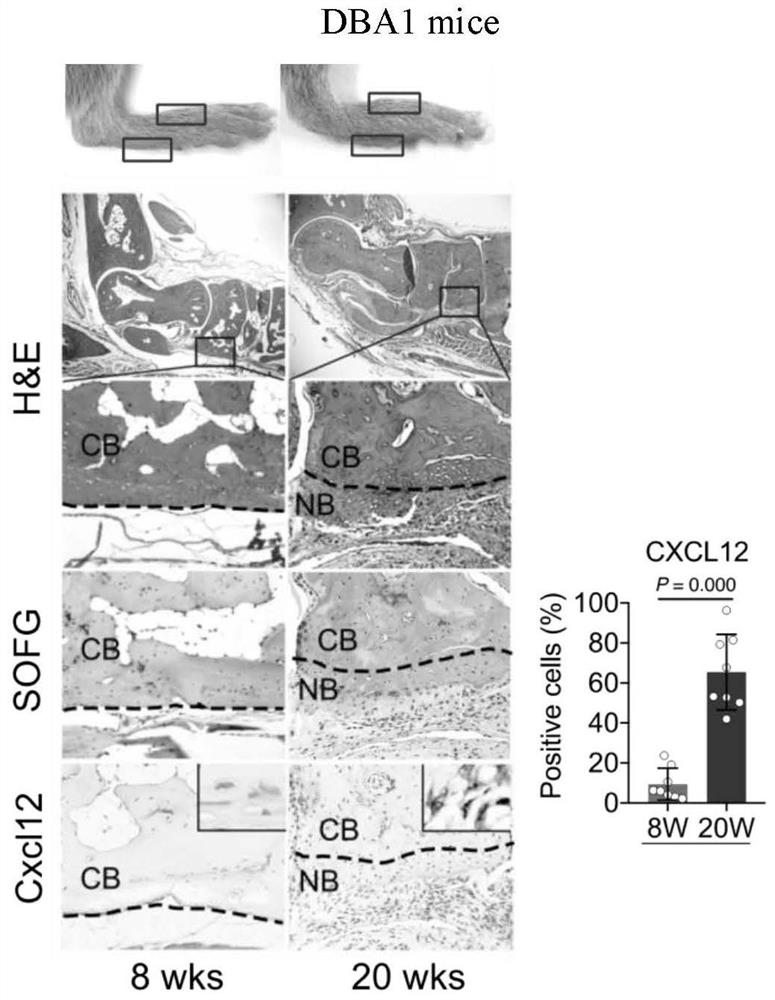Application of CXCL12/CXCR4 signaling pathway as target spot in preparation of medicine for treating or preventing heterotopic ossification
A heterotopic and drug-based technology, applied in the field of biomedicine, can solve unclear problems
- Summary
- Abstract
- Description
- Claims
- Application Information
AI Technical Summary
Problems solved by technology
Method used
Image
Examples
Embodiment 1
[0051] Embodiment 1 Model establishment and general experimental method
[0052] All animal experiments were approved by the Ethics Committee of the applicant's unit and carried out in strict accordance with the requirements.
[0053] 1. Establishment of spontaneous arthritis DBA / 1 mouse model
[0054] Male 8-week-old DBA / 1 mice (Beijing Weitong Lihua Experimental Animal Company) were obtained, and 9 mice / cage were raised together. They were divided into experimental group and control group, with 3 cages in each group.
[0055] Inflammation score was recorded to observe the clinical symptoms of arthritis, mice were scored twice a week, 0: no symptoms; 1: redness and swelling of one toe; 2: redness and swelling of more than one toe; 3: toe deformity; 4 : Foot deformity or ankle joint involvement. Both hind paws were evaluated to obtain a maximum score of 8, divided by the foot number 2, and the average value recorded.
[0056] The osteogenic sites were scanned by μCT at 8, ...
Embodiment 2
[0073] Example 2 High expression of CXCL12 at the site of ectopic new bone formation in the DBA / 1 mouse model
[0074]As shown in Figure 3, CXCL12 in ectopic osteogenesis sites was high in AS-related animal models (including DBA1 spontaneous inflammatory osteogenesis model, (proteoglycan-induced spondylitis) PGIS model and (semi-Achilles tendon transection) SMTS mouse model) Express.
[0075] In the AS-related animal model DBA1 spontaneous inflammatory osteogenesis model, the expression of CXCL12 in the plantar ectopic ossification site was significantly increased when the model was established to 20 weeks; in the PGIS model, when the model was established to 20 weeks, the paradiscal ligament of the spine was ectopic The expression of CXCL12 in the osteogenic site was significantly increased; in SMTS mice, the expression of CXCL12 in the ectopic osteogenic site at the start and end of the Achilles tendon was high when the model was established to 12 weeks.
Embodiment 3
[0077] Such as Figure 4 As shown, Micro-CT showed that in the DBA / 1 mouse inflammatory osteogenesis model (modeling 20 weeks), plerixafor significantly reduced the ectopic bone formation in the plantar of DBA1 mice, while the ectopic osteogenesis In the tissues, the Prx1+ osteogenic precursor cells in the plerixafor group were significantly reduced. Micro-CT showed that plerixafor significantly reduced ectopic bone formation at the paradiscal ligament of the spine in a mouse model of PGIS. SOFG staining showed that in the mouse spinal paradiscal ligament osteogenesis model, plerixafor significantly reduced the ectopic bone formation in the spinal paradiscal ligament. In the ectopic osteogenic tissue, the Sca1+ osteogenic precursor cells in the plerixafor group were significantly reduced. Micro-CT showed that in a mouse model of SMTS, plerixafor significantly reduced ectopic bone formation in the Achilles tendon of Achilles tendon hemisection mice. SOFG staining showed that...
PUM
 Login to View More
Login to View More Abstract
Description
Claims
Application Information
 Login to View More
Login to View More - R&D
- Intellectual Property
- Life Sciences
- Materials
- Tech Scout
- Unparalleled Data Quality
- Higher Quality Content
- 60% Fewer Hallucinations
Browse by: Latest US Patents, China's latest patents, Technical Efficacy Thesaurus, Application Domain, Technology Topic, Popular Technical Reports.
© 2025 PatSnap. All rights reserved.Legal|Privacy policy|Modern Slavery Act Transparency Statement|Sitemap|About US| Contact US: help@patsnap.com



